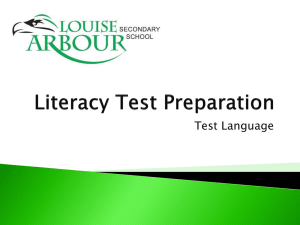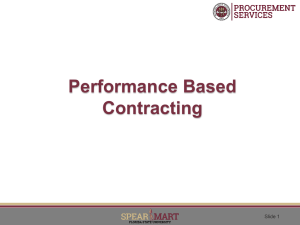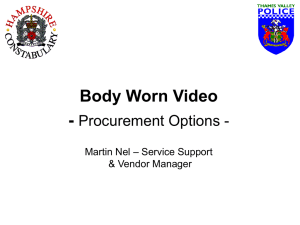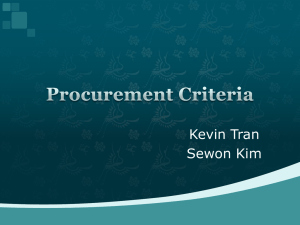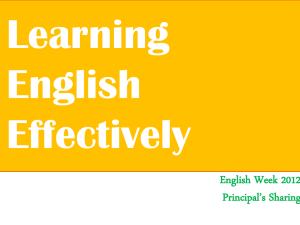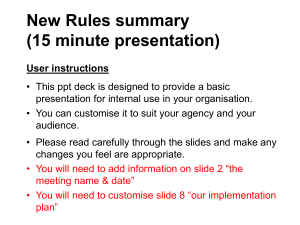Teaming and Developing_a_Winning_Proposal 25 July 2013
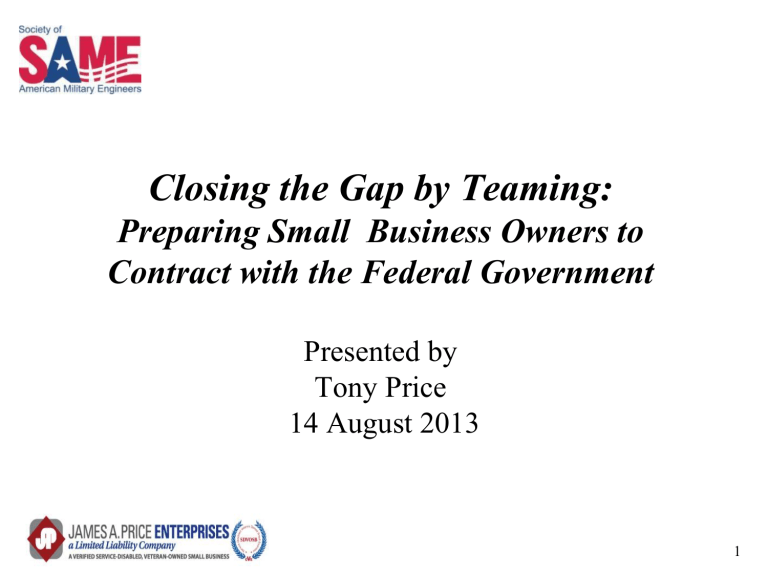
Closing the Gap by Teaming:
Preparing Small Business Owners to
Contract with the Federal Government
Presented by
Tony Price
14 August 2013
1
•
Every contract award is like winning the Super Bowl
•
Every new request for proposal is a new Super Bowl
•
You will not win every Super Bowl but it sure is nice being in the game
2
Overview of
Federal Government Contracting
USA – LARGEST Procurer of Supplies and Services Worldwide
Around 2,000 buying agencies in the Federal Government
USA – Spends $570+ Billion of Annual Budget on Goods and
Services
DoD spends $361.3B or about 65% of that
USA – Statutory Minimum 23% of Annual Spending to ALL
SBs via 15 USC 644(g)
If Small Businesses want to be to
“ in the game
”
, they must know how
“ play the game
” – to successfully “
COMPETE and WIN
”
!
You cannot win without a strong and well-rounded team.
3
The Federal Procurement
“
GAME
”
•
The GAME
•
The PROCESS
•
The RULES
•
The PLAYERS
•
The STRATEGY
•
Procurement of All Supplies and Services for the United
States Federal Market
•
Federal Acquisition SYSTEM o 3 Branches of Government o Checks / Balances o Taxpayer Funds o Annual Appropriations
•
Federal Acquisition Regulations
(FAR) and its Supplements o Acquisition Central www.arnet.gov
•
Buyers: Contracting Officers
Sellers: Prime Contractors,
Subcontractors, Vendors
•
Developing a Competitive
Winning Proposal Document
4
Government and Commercial
Procurement
• Four main differences between Government and commercial procurement: o Government-unique audit and accounting requirements o Government-unique specifications and standards o Technical data rights o Government-unique contract requirements
5
Government and Commercial
Contracting
Government Commercial
Orientation of Procurement Best value/low cost
Procurement Structure
Role of Congress/ Judicial
Branches
Commitment Authority
Acceptance
Termination Clause
Suspension of Work
Contract Litigation
Performance and
Social/Economic
Formal defined by FAR
Provides direct input and guidance
Actual
Final and Conclusive
No anticipatory profit/fee
Cost recovery, no profit/fee
Federal law prevails
Less formal
Uniform Commercial Code
(UCC)
Implied
Flexible
Usually contains anticipatory profit/fee
Profit/fee not prohibited negotiable
State law prevails
6
Tips On Doing Business with Federal
Agencies “ or with anybody else for that matter ”
Tip #1 - Do your homework…Surf the web.
Tip #2 - Demonstrate responsiveness
Tip #3 - Understand the opportunities
Tip #4 - Let the client talk. Listen carefully to what they have to say.
Tip #5 - Market project managers, they know the clients and they are the folks bringing in the money
7
Tips Continued
Tip #6 - Execute and execute well
Tip #7 - Bad performance is a death sentence to a small business
Tip #8 - Small businesses are important but not at the expense of quality
Tip #9 - Find your own work
Tip #10 - Demonstrate that you know what you are doing
8
So where do you start?
• Know yourself: Understand your capabilities (superior product, competitive pricing, outstanding customer service), Be realistic
•
Determine your market (geographic, etc.)
• Know your customer: Do some homework (see next slide) o Federal Procurement Process o Websites o Small Business Administration o Other advocacy agencies (SBDCs/PTACs) o YOUR SMALL BUSINESS SPECIALIST
9
So what can you do?
•
Visit potential clients
•
Get to know your clients ’ business
•
Ask what “ keeps them up at night ”
•
Study the money
•
Don’t forget your subcontractors
10
What are “ they ” looking for in a contractor?
•
Highly qualified and capable firm
•
Address all criteria
•
Fully articulate your approach
•
Relevant experience is key
•
Fully address any weaknesses
•
Past performance will be important
11
What do Primes
look
for?
•
High quality past performance
• Financial stability
• Excellent reputation
• Reasonable costs
•
Good safety record
•
Reliability
• Customer focus
• Responsiveness
• Relevant experience
•
Quality management and people
• Able and willing to take on new work
•
Willingness to strive for a win/win situation
• Ability to work as a team
12
Capability presentations
• Arrange thru your small business specialist
•
Sell your capabilities
• Product demos
•
Reference material (brochures, pamphlets, line cards)
•
Get a debrief/feedback
•
Follow-up
13
Marketing
•
Same techniques apply when marketing to large, prime contractors
•
If practicable get general information on an activity before you visit o Who should you talk to or meet with?
o Respect “ Chain of Command ” or protocol o Prepare – review web-sites, etc.
•
Consider what can your business can do for them?
14
Marketing
• Networking o Chambers, small business groups, professional societies (SAME) and organizations o Attend seminars or hold your own (be a speaker at industry functions) o Networking with competitors o News releases
•
Your website
•
Always carry business cards
•
Referrals o Ask current clients to refer you to others
15
Marketing
• It ’ s not only who you know that counts, it ’ s who your clients know that is important, too.
•
Relationships can be more important than the product or service sold (especially in a competitive market).
•
Learn to accept rejection gracefully .
•
Do you believe in your product and company?
•
Would you do business with yourself?
16
Outreach conferences
•
Who sponsors Outreach Conferences?
o Members of Congress o Various Government Agencies o Chambers of Commerce
•
Vendor Days (local emphasis) o Government Credit Card o Information Technology, Furniture, etc o High Tech or Environmental
•
Focused Events- Specific Audiences targeted o Specific Acquisition (Pre-solicitation) o Specific small business group (WOSB, 8(a), Vet)
Subcontracting
• The Small Business Act requires that small business firms have maximum opportunity to participate as subcontractors on Federal contracts o Small Business o Small Disadvantaged Business/8(a)
Historically Black Colleges and Universities (HBCU/MI)
- applies to DoD o Women-Owned Small Business o HUBZone Small Business o Service Disabled Veteran-Owned Small Business o Veteran-Owned Small Business
18
Proposal Case Study - Assumptions
• Customer
•
Solicitation Type
•
Procurement
•
Offeror (or Bidder)
• Proposal Due Date
Now how do I get started …?
• U.S. Federal Government
Department or Agency
• Request for Proposal
(RFP)(FAR Part 15)
•
Complex Services or Manufactured
Products Based Upon Specs/Dwgs, or Performance Description > $1M
•
Service Disabled Veteran
Owned (SDVO) o Prime Contractor o Dedicated Team Member
• 30 Calendar Days from
Receipt of RFP
19
Breaking Down the Proposal Requirements
How to Analyze the RFP …
•
Read the Entire Document as a Whole
•
Dissect the Statement of Work (SOW),
Specifications, Drawings, Technical
Descriptions
•
Develop Work Breakdown Structure
(WBS)
•
Review the RFP Instructions & Evaluation
Criteria
•
Responsiveness v. Responsibility
20
Breaking Down the Proposal Requirements
How to Analyze the RFP …
•
Relate the Source Selection Process with the
Proposal Development (Point to Point) – Don
’ t
Miss ANYTHING!
•
Develop a Compliance Checklist
•
Correlate Each Requirement to an Evaluation
Criteria
•
Develop a “ Proposal Outline ” Handout for the
Kick-off Meeting
•
Submit Request for Information" (RFI's) as outlined in the solicitation instructions if the specification is not clear. RFI's usually cut-off about 2-5 days before solicitation closes.
21
Identifying the Team Members
•
• Identify the Best Available Candidates for the Proposal Team
•
Make Writing Assignments with Members Strengths in Mind
- THIS IS NO TIME TO EXPERIMENT OR TRAIN o Technical (or Engineering) Specialist o Management/Operations Specialist o Estimator or Cost(s) Analyst o Contracts Specialist o Logistics/Procurement/Small Business Specialist o Quality/Environmental Health & Safety (EH&S) Specialist o Past Performance/Projects & Resumes Specialist o Expert Word Processor o Graphics Designer/Artist o Editor & Proof-Reader o Proposal Coordinator
22
Identifying the Team Members
• Don
’ t Overlook the Need for: o Consultants – Subject Matter Experts (SME)
Fill Gaps in Team Manpower & Experience
Add Expert Support in Niche Areas
Provide Inside Knowledge of Customer & Competitors o Teaming Partners – Large & Small Business Providers of Supplies and Services
Exclusive v. Non-Exclusive
Formal v. Informal o Dedicated Subcontractor/Supplier Competitive Pools o Reproduction Function - Internal or External o Overnight Courier or Other Transportation Carrier
23
Selecting the Team
• Selecting Teaming Partners o Assess team member capabilities
Business, financial, other resources o Assess team member past performance o Assess team member past performance with the client o Assess team member relationship with the client o Assess legal constraints
Organizational conflicts of interest
Debarments/suspensions
Qualification requirements o Assess team chemistry
Management styles, corporate cultures, strategic visions
• Successful Teaming Qualities o Compatible contractors o Good teaming agreements in place
24
Teaming
• Why would small businesses want to team?
o Enables firms to complement each others capabilities o May enable firms to offer the best combination of performance, cost and delivery o May enable small businesses to successfully compete for larger scale contracts o To develop relationships and capture work on multiple opportunities
25
Teaming
•
Most teams are either: o Prime/Subcontractor relationship o Joint Ventures
•
Prime/Subcontractor Relationship: o Prime is responsible for contract performance o Government has privity of contract only with the prime o Relationships normally identified before offer is submitted o SBA checks for affiliation
26
Following Award - Debriefs and Lessons-Learned …
•
When the Customer Announces the Contract Winner – Always Request a Debrief – WHETHER YOU WIN OR LOSE …
•
As the Winner – o Learn About What You DID BETTER than Everyone Else –
Strengths o Learn About What May Need Improvement for the Future –
Weaknesses o Continue to Develop a Better Relationship with the Customer o Build Customer Trust and Show Humility o Begin to Cultivate Follow-On Work – It
’ s never too early
•
FIX THE WEAKNESSES IDENTIFIED IN THE DEBRIEF!
27
Following Award - Debriefs and Lessons-Learned …
•
As the Unsuccessful Offeror – o Learn about the Proposal Weaknesses v. the Proposal
Strengths o Learn more about What the Customer Really Wants and
Why You Didn
’ t Provide it THIS TIME ….. o Continue Gathering Business Intelligence (BI) o Request Info regarding New Opportunities – It too early …
’ s never
•
FIX THE WEAKNESSES IDENTIFIED IN THE DEBRIEF
!
28
Acronym List
ARNET – Acquisition Reform Network
BAA – Broad Agency Announcement
BD – Business Development
BI – Business Intelligence
CCR – Central Contractor Registration
DFARS – Defense FAR
DHS – Department of Homeland Security
DoD – Department of Defense
EH&S – Environmental, Health, &
Safety
EO – Executive Order
FAR – Federal Acquisition Regulations
IFB – Invitation for Bid
FSS – Federal Supply Schedule
FOIA – Freedom of Information Act
GFY – Government Fiscal Year
GSA – General Services Administration
GWAC – Government-Wide Acquisition
Contract
ID/IQ – Indefinite Quantity/Indefinite
Delivery
MAC – Multiple Award
ODC – Other Direct Cost(s)
PL – Public Law
RFP – Request for Proposal
RFQ – Request for Quotation
SB – Small Business
SBA – Small Business Administration
SDB – Small Disadvantaged Business
SDVO – Service Disabled Veteran
Owned
SME – Subject Matter Expert
SOW – Statement of Work
UCF – Uniform Contract Format
USA – United States of America
USC – United States Code
WBE – Women Business Enterprise
WBS – Work Breakdown Structure
WOSB – Woman-Owned Small Business
www.militarywords.com
29
Business Opportunities Websites
Free/No-Cost
www.sba.gov
www.fedbizopps.gov
www.grants.gov
www.gsa.gov
www.arnet.gov
www.firstgov.gov
www.defenselink.mil
www.dla.mil/db/procure m.htm
Paid Fee Sites
www.epipeline.com
www.eagleeyeinc.com
www.input.com
www.onvia.com
www.bid-search.com
www.softshare.com
www.cch.com
30
Reference Materials – Self Study
•
Federal Acquisition Regulations (FAR)
•
FAR Part 10 – Market Research
•
FAR Part 11 – Describing Agency Needs
•
FAR Part 12 – Acquisition of Commercial Items
•
FAR Part 13 – Simplified Acquisition Procedures
•
FAR Part 14 – Sealed Bidding
•
FAR Part 15 – Negotiated Procurements
•
FAR Part 16 – Types of Contracts
•
FAR Part 17 – Special Contracting Methods
•
FAR Part 19 – Small Business Programs
•
Periodicals
•
National Contract Management Association Magazine & Journal
•
National Association of Purchasing Managers – Institute of Supply Mgmt.
Magazine
•
National Defense Industrial Association Magazine
•
Government Executive Magazine
•
Websites
• www.arnet.gov
• www.firstgov.gov
• www.acq.osd.mil
31
Questions?
•
Ask me now or,
•
call me at 410-688-5116 or
•
email your questions directly to:
Tony.Price@PriceEnterprisesLLC.com
32
